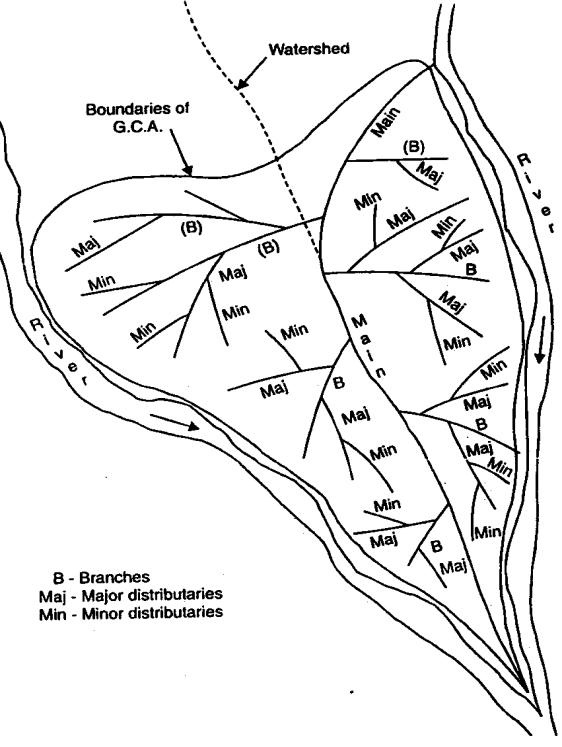Chapter: Civil : Water Resources and Irrigation Engineering : Canal Irrigation
Canals
CANAL IRRIGATION
CANALS
Conveyance
subsystem for irrigation includes open channels through earth or rock
formation, ones constructed in partially excavated sections or above ground,
pipe lines installed either below or above the ground surface, and tunnels
drilled through high topographic obstructions. Formation conduits of a typical
gravity project are usually open channels through earth or rock federations.
These are called canals.
The canal
is defined as an artificial channel constructed on the ground to carry water
from outer or another canal or a reservoir to the fields. Usually, canals have
a trapezoidal cross-section. Canals can be classified in many ways.
Based on
the nature of source of supply, a canal can be either a permanent or an
gradation canal. A permanent canal has a continuous source of water supply.
Such canals are called perennial canals. An inundation canal draws its supplies
from a river only during high stages of the river. Such canals do not have any
head works for diversion of river to the canal, but are provided with a canal
head regulator.
Depending
on their function, canals can also be classified as: (i) irrigation, (ii)
navigation, (iii) power, and (iv) feeder canals. An irrigation canal carries
water from its source to agricultural fields. Canals used for transport of
goods are known as navigation canals. Power canals are field to carry water for
generation of hydroelectricity. A feeder canal feeds two or more canals.
A canal
can serve more than one function. The slope of an irrigation canal is generally
than the ground slope in the head reaches of the canal and, hence, vertical
falls have often we constructed. Power houses may be constructed at these falls
to generate power and, thus, irrigation canal can be used for power generation
also.
CANAL IRRIGATION
CANALS
Conveyance
subsystem for irrigation includes open channels through earth or rock
formation, ones constructed in partially excavated sections or above ground,
pipe lines installed either below or above the ground surface, and tunnels
drilled through high topographic obstructions. Formation conduits of a typical
gravity project are usually open channels through earth or rock federations.
These are called canals.
The canal
is defined as an artificial channel constructed on the ground to carry water
from outer or another canal or a reservoir to the fields. Usually, canals have
a trapezoidal cross-section. Canals can be classified in many ways.
Based on
the nature of source of supply, a canal can be either a permanent or an
gradation canal. A permanent canal has a continuous source of water supply.
Such canals are called perennial canals. An inundation canal draws its supplies
from a river only during high stages of the river. Such canals do not have any
head works for diversion of river to the canal, but are provided with a canal
head regulator.
Depending
on their function, canals can also be classified as: (i) irrigation, (ii)
navigation, (iii) power, and (iv) feeder canals. An irrigation canal carries
water from its source to agricultural fields. Canals used for transport of
goods are known as navigation canals. Power canals are field to carry water for
generation of hydroelectricity. A feeder canal feeds two or more canals.
A canal
can serve more than one function. The slope of an irrigation canal is generally
than the ground slope in the head reaches of the canal and, hence, vertical
falls have often we constructed. Power houses may be constructed at these falls
to generate power and, thus, irrigation canal can be used for power generation
also.
Similarly,
irrigation canals can also be utilized for the transportation of goods and
serve navigation canals. Inland navigation forms a cheap means of
transportation of goods and, hence, must be developed. However, in India,
inland navigation has developed only to a limited sufficient. This is mainly
due to the fact that irrigation canals generally take their supplies from
Ruvial Rivers and, as such, must flow with sufficient velocity to prevent
siltation of the canal. Each velocity makes upstream navigation very difficult.
Besides, the canals are generally aligned on the water shed is the dividing
line between the catchment areas of two drains so that water may reach the
fields on both sides by flow. This alignment may not be suitable for navigation
which requires the canal to pass through the whereas in the vicinity of
industries.
An irrigation canal system consists
of canals of different sizes and capacities. Accordingly, the canals are
classified as: (i) main canal, (ii) branch canal, (iii) major distributary,
(iv) minor distributary, and (v) water course.

Figure: Layout of an irrigation canal
network
The main
canal takes its supplies directly from the river through the head regulator and
acts as a feeder canal supplying water to branch canals and major
distributaries. Usually, direct irrigation is not carried out from the main
canal.
Branch
canals (also called ‘branches’) take canals generally carry a discharge higher
than 5m3/s and act as a feeder canals for major and minor
distributaries. Large branches are rarely used for direct irrigation. However,
outlets are provided
on smaller branches for direct irrigation.
Major distributaries(aries’lsocalledorrajbaha)3/s‘disofdischarge.
car
These distributaries take their
supplies generally from the branch canal and sometimes from the main canal. The
distributaries feed either Watercourse through outlets minor distributaries.
Minor distributaries (also
called
‘minors’)adischargelessthan are
0.25 m3/s and feed the
watercourses for irrigation. They generally take their supplies from major
distributaries or branch canals and rarely from the main canals.
A
watercourse is a small channel which takes its supplies from an irrigation
channel generally distributaries) through an outlet and carries water to the
various parts of the area be irrigated through the outlet.
Related Topics